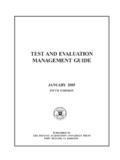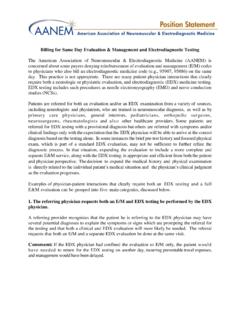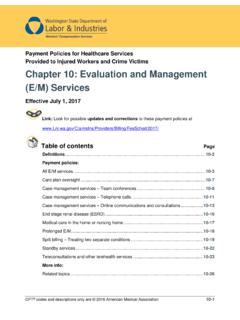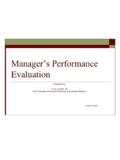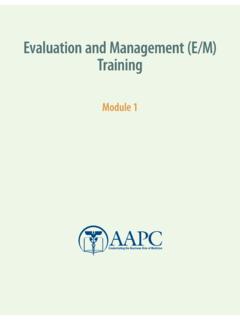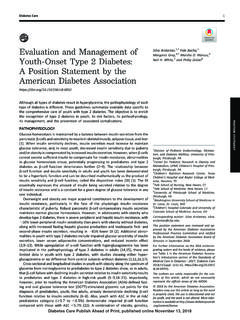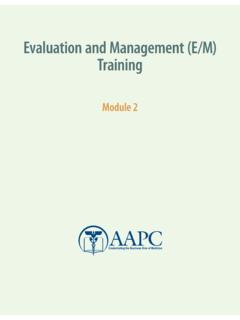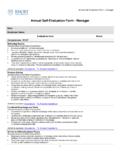Transcription of Evaluation and Management (E/M) - Oxford Health Plans
1 UnitedHealthcare Oxford Reimbursement Policy Evaluation AND Management (E/M) POLICY. Policy Number: ADMINISTRATIVE T0 Effective Date: March 1, 2018. Table of Contents Page Related Policies INSTRUCTIONS FOR USE .. 1 None APPLICABLE LINES OF BUSINESS/PRODUCTS .. 1. APPLICATION .. 1. OVERVIEW .. 1. REIMBURSEMENT GUIDELINES .. 2. DEFINITIONS .. 3. QUESTIONS AND ANSWERS .. 3. ATTACHMENTS .. 3. REFERENCES .. 4. POLICY HISTORY/REVISION INFORMATION .. 4. INSTRUCTIONS FOR USE. The services described in Oxford policies are subject to the terms, conditions and limitations of the member's contract or certificate. Unless otherwise stated, Oxford policies do not apply to Medicare Advantage members.
2 Oxford reserves the right, in its sole discretion, to modify policies as necessary without prior written notice unless otherwise required by Oxford 's administrative procedures or applicable state law. The term Oxford includes Oxford Health Plans , LLC and all of its subsidiaries as appropriate for these policies. Certain policies may not be applicable to Self-Funded members and certain insured products. Refer to the member specific benefit plan document or Certificate of Coverage to determine whether coverage is provided or if there are any exclusions or benefit limitations applicable to any of these policies. If there is a difference between any policy and the member specific benefit plan document or Certificate of Coverage, the member specific benefit plan document or Certificate of Coverage will govern.
3 UnitedHealthcare may also use tools developed by third parties, such as the MCG Care Guidelines, to assist us in administering Health benefits. The MCG Care Guidelines are intended to be used in connection with the independent professional medical judgment of a qualified Health care provider and do not constitute the practice of medicine or medical advice. APPLICABLE LINES OF BUSINESS/PRODUCTS. This policy applies to Oxford Commercial plan membership. APPLICATION. This reimbursement policy applies to services reported using the 1500 Health Insurance Claim Form (a/k/a CMS-1500). or its electronic equivalent or its successor form. This policy does not apply to claims billed on a UB-04 form.
4 This policy applies to all products and all network and non-network physicians and other qualified Health care professionals, including, but not limited to, non-network authorized and percent of charge contract physicians and other qualified Health care professionals. OVERVIEW. This policy is intended to address Evaluation and Management (E/M) services are reported using Current Procedural Terminology (CPT ) codes 99201-99350. Each code contains three (3) "key" components: history, examination and medical decision making, which are used as a basis for selecting a level of E/M code that best describes the service rendered to the patient. Evaluation and Management (E/M) Policy Page 1 of 4.
5 UnitedHealthcare Oxford Reimbursement Policy Effective 03/01/2018. 1996-2018, Oxford Health Plans , LLC. The E/M coding section of the CPT book is divided into broad categories such as office/outpatient visits, inpatient hospital visits, consultations, etc. Many of these categories are further divided into two or more subcategories and are further classified into levels of E/M appropriate for that service type such as: Office Visits: New and established patients Hospital E/M Services: Initial and subsequent; further based on the intensity of care provided ( , critical care or observation). Other E/M Services: Based on location, , emergency department services The classification is important because the nature of the work varies by type of service, place of service, the patient's medical status, and other code criteria, along with the amount of provider work and documentation required.
6 CMS published E/M documentation guidelines in 1995 and 1997. These guidelines describe three key components of E/M services: History, Examination, and Medical decision making. These components appear in the descriptors for most basic E/M codes (office and other outpatient services, hospital observation services, hospital inpatient services, consultations, emergency department services, nursing facility services, domiciliary care services, and home services) and describe increasing levels of complexity. The documentation of these three components (history, examination and medical decision making) depends on clinical judgment of the provider and the nature of the presenting problem(s).
7 Each of these three components has different levels of complexity. The selection of the appropriate level of complexity and appropriate selection of the level of service must be reflected in the medical record documentation. REIMBURSEMENT GUIDELINES. All E/M Services When assigning an E/M Level of Service for a patient Encounter, significant factors to consider are the nature of the presenting problem (NoPP) and the complexity of medical decision making (MDM). The expectation of documentation necessary to substantiate the claim as billed will follow the general principles of medical record documentation which apply to all types of medical and surgical services in all settings.
8 While E/M. services vary in several ways, such as the nature and amount of physician work required, the following general principles help ensure that medical record documentation for all E/M services is appropriate: The medical record should be complete and legible;. The documentation of each patient Encounter should include but not be limited to: o Reason for the Encounter and relevant history, physical examination findings, and prior diagnostic test results;. o Assessment, clinical impression, or diagnosis;. o Medical plan of care;. o Date and legible identity of the observer;. o If not documented, the rationale for ordering diagnostic and other ancillary services should be easily inferred.
9 O Past and present diagnoses should be accessible to the treating and/or consulting physician;. o Appropriate Health risk factors should be identified;. o The patient's progress, response to and changes in treatment, and revision of diagnosis should be documented;. o The diagnosis and treatment codes reported on the Health insurance claim form or billing statement should be supported by documentation in the medical record;. o Review of past medical records must include a summary of relevant information gleaned from this review in order to receive credit in the Amount and Complexity of Data section. While there is no prohibition on the use of proprietary templates, documentation from either an electronic Health record (EHR) or hard-copy that appears to be cloned (selected information from one source and replicated in another location by copy/paste methods) from another record, including but not limited to history of present illness (HPI), exam, and MDM, would not be acceptable documentation to support the claim as billed.
10 For example, HPI should be the provider's individual description of the development of the patient's present illness from the first sign and/or symptom, or from the previous Encounter to the present; the exam should be the individual description of the patient's exam at the time of the Encounter and MDM should also be individualized to the Encounter for the patient to outline a specific assessment and plan of care. Medical record documentation should be provided upon request. Evaluation and Management (E/M) Policy Page 2 of 4. UnitedHealthcare Oxford Reimbursement Policy Effective 03/01/2018. 1996-2018, Oxford Health Plans , LLC. E/M Services Performed in an Emergency Department (ER/ED) Place of Service CPT codes 99281-99285 are used to report E/M services rendered in an ER/ED place of service.
